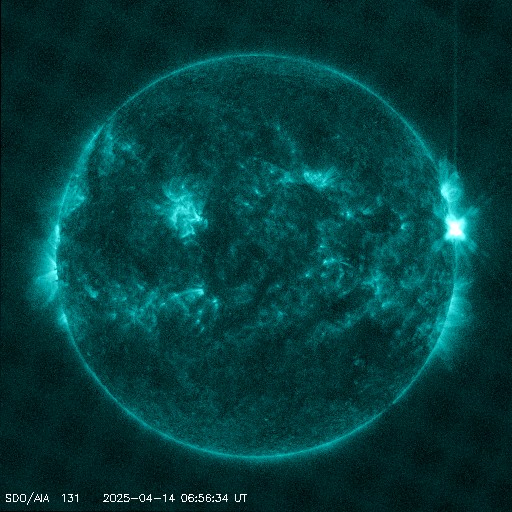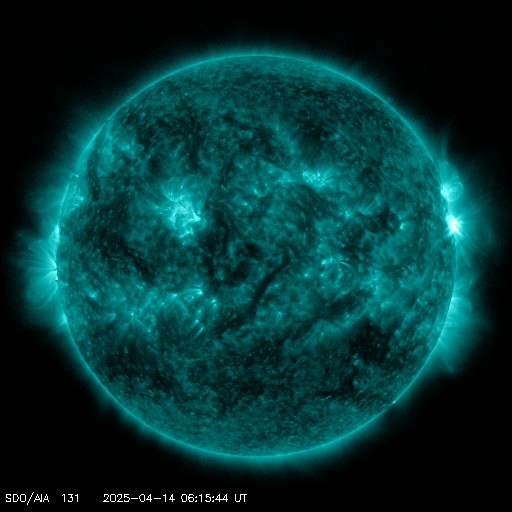Viewing archive of Wednesday, 12 June 2002
Solar activity report
Any mentioned solar flare in this report has a scaling factor applied by the Space Weather Prediction Center (SWPC). Because of the SWPC scaling factor, solar flares are reported as 42% smaller than for the science quality data. The scaling factor has been removed from our archived solar flare data to reflect the true physical units.
Report of Solar-Geophysical Activity 2002 Jun 12 2200 UTCPrepared by the NOAA © SWPC and processed by SpaceWeatherLive.com
Joint USAF/NOAA Report of Solar and Geophysical Activity
SDF Number 163 Issued at 2200Z on 12 Jun 2002IA. Analysis of Solar Active Regions and Activity from 11-2100Z to 12-2100Z
Solar activity was at low levels. Optically verified
using EIT imagery, Region 9987 (S15W56) produced a C1 x-ray flare at
12/0903 UTC. This region underwent slight decay today. Less
penumbral coverage seen in trailing cluster of spots, although
region continues to exhibit beta-gamma magnetic characteristics.
Region 9991 (S22E04) showed slight growth in penumbral coverage
during the period. Other than occasional point brightening and
minor dark surging, this region was stable through the period. A
Type II radio sweep with an estimated shock velocity of 450 km/s
occurred at 12/0145 UTC. Source region of the sweep is believed to
have originated from beyond the northeast limb of the visible disk.
Regions 9996 (S27E46), 9997 (N08E73), and 9998 (N15E74) were
numbered today.
IB. Solar Activity Forecast
Solar activity is expected to be at
low levels. Region 9987 remains capable of producing an isolated
low level M-class flare.
IIA. Geophysical Activity Summary 11-2100Z to 12-2100Z
The geomagnetic field activity was at quiet to unsettled levels.
IIB. Geophysical Activity Forecast
The geomagnetic field activity
is expected to continue at quiet to unsettled levels. Day three of
the forecast period may experience isolated active conditions in
response to a southern hemispheric high speed stream coronal hole
becoming favorably positioned.
III. Event Probabilities 13 Jun to 15 Jun
| Class M | 25% | 25% | 25% |
| Class X | 01% | 01% | 01% |
| Proton | 01% | 01% | 01% |
| PCAF | green | ||
IV. Penticton 10.7 cm Flux
Observed 12 Jun 142 Predicted 13 Jun-15 Jun 145/145/155 90 Day Mean 12 Jun 180
V. Geomagnetic A Indices
Observed Afr/Ap 11 Jun 007/012 Estimated Afr/Ap 12 Jun 005/010 Predicted Afr/Ap 13 Jun-15 Jun 005/008-006/008-010/010
VI. Geomagnetic Activity Probabilities 13 Jun to 15 Jun
| A. Middle Latitudes | |||
|---|---|---|---|
| Active | 10% | 10% | 20% |
| Minor storm | 01% | 01% | 10% |
| Major-severe storm | 01% | 01% | 01% |
| B. High Latitudes | |||
|---|---|---|---|
| Active | 15% | 15% | 25% |
| Minor storm | 05% | 05% | 10% |
| Major-severe storm | 01% | 01% | 01% |
All times in UTC
Current data suggests there is a slight possibility for aurora to appear at the following high latitude regions in the near future
Fairbanks, AKLatest news
Latest forum messages
Ask your obscure/"stupid" space weather questions. 3552025/04/12-13 Filament CMEs 2025/04/16 G2 Watch 56Potential AR4062 9Filaments and prominences 62Incoming & Unnumbered Active Regions 1708
More topicsSupport SpaceWeatherLive.com!
A lot of people come to SpaceWeatherLive to follow the Sun's activity or if there is aurora to be seen, but with more traffic comes higher server costs. Consider a donation if you enjoy SpaceWeatherLive so we can keep the website online!

Latest alerts
Monday, 14 April 2025
23:15 UTC - Geomagnetic activity
Active geomagnetic conditions (Kp4) Threshold Reached: 23:01 UTC
07:09 UTC - Solar flare
Moderate M4.28 flare from sunspot region 4055
06:48 UTC - Radio Blackout
Minor R1 radio blackout in progress (≥M1 - current: M1.53)
06:24 UTC - Solar flare
Moderate M1.49 flare from sunspot region 4055
06:06 UTC - Radio Blackout
Minor R1 radio blackout in progress (≥M1 - current: M1.16)
Space weather facts
| Last X-flare | 2025/03/28 | X1.1 |
| Last M-flare | 2025/04/14 | M4.2 |
| Last geomagnetic storm | 2025/04/06 | Kp5 (G1) |
| Spotless days | |
|---|---|
| Last spotless day | 2022/06/08 |
| Monthly mean Sunspot Number | |
|---|---|
| March 2025 | 134.2 -20.4 |
| April 2025 | 128.8 -5.4 |
| Last 30 days | 129.1 -15.1 |





